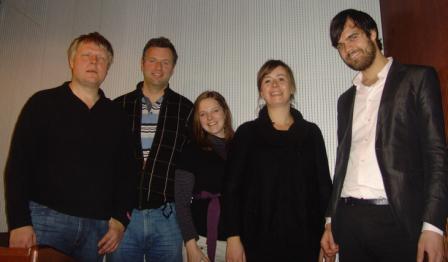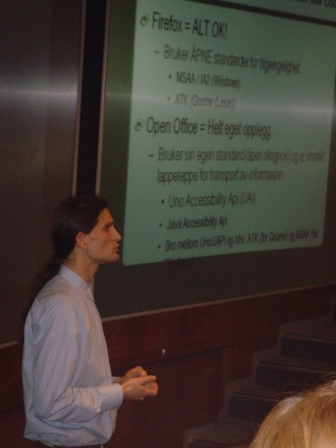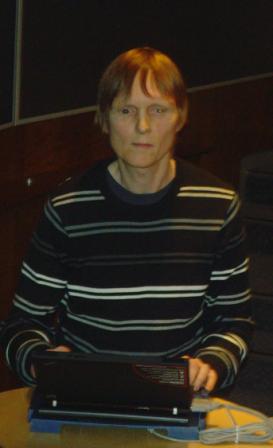Universal Design is not sexy!
The Director of the Free Software Centre, Heidi Arnesen Austlid, has often experienced that universal design is not at the top of the agenda. Austlid and other speakers at the seminar have however noted increasing interest, and the seminar at Fornebu was important for further work with free software.
Story by: Morten Tollefsen - 27.11.2008
The seminar on November 21st was a follow-up to the seminar the Resource Network for Universal ICT conducted last autumn, when disability challenges and opportunities in free software was defined as one of the most important research and development tasks in the field of universal design and ICT.

Presentations
Presentations from the Universal IKT seminar are available for download!
Some main points from the speeches are included here. The presentations will published as soon as they are available.
Jørund Leknes (political advis0r for Ministry of Government Administration and Reform)
- Anti-discrimination Act is based on Syse committee
- The law requires universal design of new ICT in July 2011, and of existing solutions in 2021
- Norge.no has resulted in competition to provide good public websites
- The winning site will be announced on 4th December
- Open standards provide a choice with respect to software (eg. html)
- Vikipedia is an example of successful development methodology
- There are also sound economic reasons to use free software
- Html, pdf and odf will be used for public sector publications from 1 January 2009
- New standards are being worked on: multimedia, the exchange of documents, ...
Morten Tollefsen (MediaLT)
- MediaLT has tested Norwegian Linux distributions and other free software
- Ubuntu distribution was used for user testing
- Open Office and a free screen reader was tested in Windows
- Open Office for Windows does not work well with screen readers and screen magnifiers NVDA (free screen reader) worked relatively well in Windows
- Many hardware-based aids for the disabled can be used in Linux
- Built in accessibility functionality in Ubuntu is comparable with what you find in Windows
- Synthetic voice and screen reader in Linux has poorer quality/functionality than in Windows
- Linux is still an exciting alternative for the visually impaired amongst other things due to cost
- Read/write aids, scanning for disabled and more. were not found in Linux
- Work should be done to stimulate interest/expertise in Linux and free software: accessible documentation, offer user support, development of screen reader and synthetic speech, the development of a DAISY-player and more
Heidi Arnesen Austlid (Director of the Free
Software Centre)
- Universal Design is not sexy! This is not right because Universal Design is important for everyone!
- Everyone should have equal digital opportunities
- Sharing Model for the public sector
- Breaking down of monopolies
- Cross party agreement on investment in free software
- Free software is not necessarily free! It is about building solutions that allow sharing/development
- Benefits both customer and supplier
- The end users are not often considered in free software communities
- About a billion a year in appointments in free software in Norway
- Why isn't universal design a natural part of software development?
- Substantial procurement expertise is important!
- 2 million to: facilitate the use of Open Office in the public sector. This will involve a lot of work on integration towards sytems. Projects will cover 3 areas: interpret, information and expertise measures, interaction /share point-like.
- Free software are happy to work on an application to the EU framework program.
- Sharing Basar (public sectors can share solutions)
Sverre Andreas Holbye (Include)

- Include develop their own assistive aids technology
- Open source! = Linux
- Open Standards!=Accessibility
- Open source! = Open standards
- User and developer problems are identical whether the source code is open or closed
- Make Access Pilot: easier to integrate the accessibility technology in Windows, new and existing products, quickly develop new products, ...
- It is important to understand user groups needs during the development of new products, and it is unlikely that all developers have such expertise
- Interoperability is important
- A little about accessibility in APIs and IBM's work
- The problem with Open Office /open source is lack of structure
- The public sector should put accessibility before of openness. Must set the same requirements as those for closed software. Which APIs will the public sector standardize on? Include will collaborate with IBM on Lotus Symphony.
Lars Bjørndal (Handytech)

- Professionals should consider Universal Design even when tit isn't ordered!
- Important to use the familiar user interface
- Do all Office work in Linux (konsoll)
- Libloi is a good example of open source. Made by View Plus, and then used by Handy Tech
- School Linux: based on kode that is not accessible for the visually impaired
- Many projects are for a limited time period and die when the project is over
- Google = user support, need for other support too.
- Developers must allow for more alternative techniques.
Group Work
The seminar was concluded with work in groups which produced many ideas for important areas of development and useful projects. It will be up to the participants to further develop ideas and possibly work together to realize some of these.

Tips noen om siden